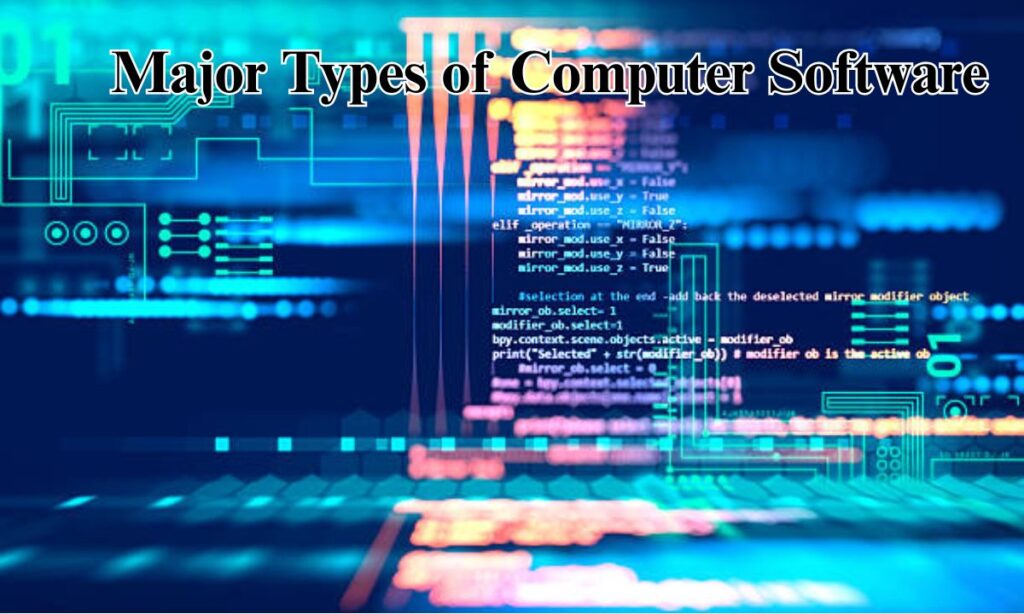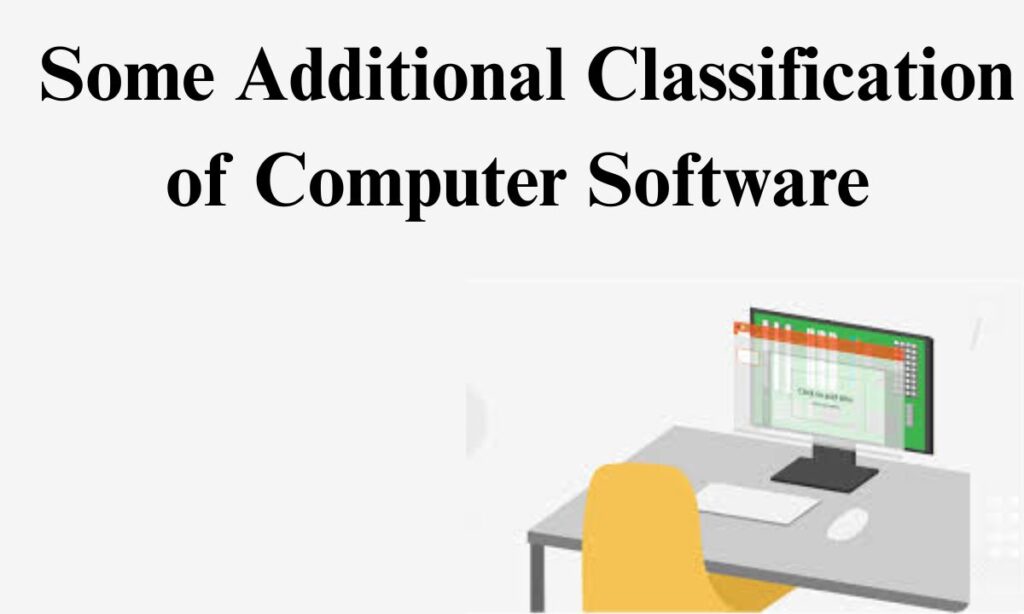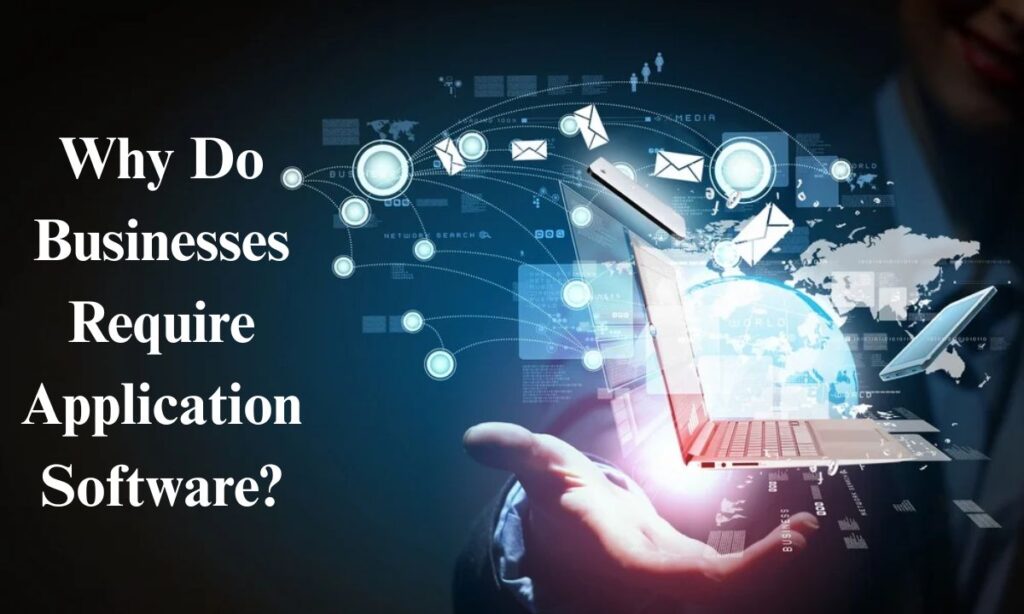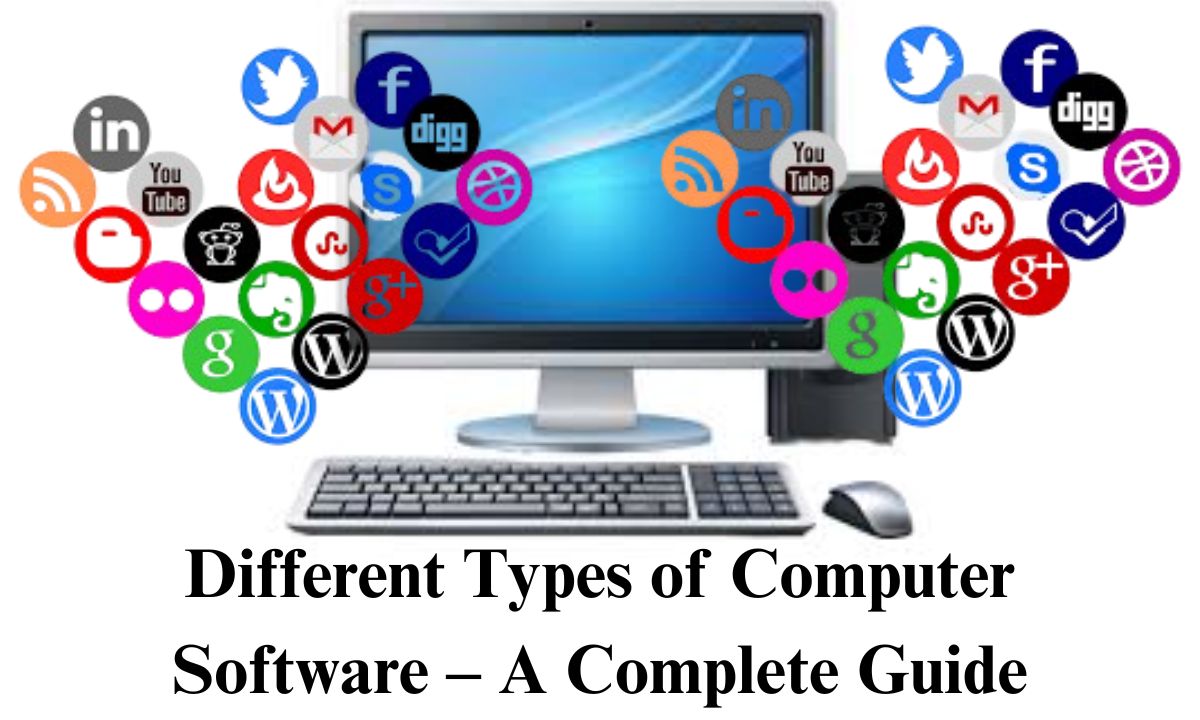Technology has revolutionized how we work and communicate. Computer software plays a crucial role in this transformation. Every device we use relies on various software applications to function properly.
Understanding different computer program categories helps you make better decisions for personal and business use.Modern computers need different types of software platforms to operate efficiently.
Each software type serves a specific purpose. Some manage hardware components while others help users complete tasks. This guide explores all major software distribution models and their practical applications.
What is Computer Software?
Computer software consists of programming codes that run on a computer processor. These computer programs give instructions to hardware components. Software acts as a bridge between users and computer hardware.
Think of software as a translator. It converts your commands into machine code that computers understand. Without software, computers would be useless boxes of metal and circuits. Every click, tap, or keystroke triggers software execution processes.
Software includes everything from simple calculators to complex business applications. The user interface you see on your screen is also part of software. Modern software handles file management, memory allocation, and hardware compatibility automatically.
Major Types of Computer Software
Computer software classification divides software into two main categories. Each category serves different purposes and has unique characteristics. Understanding these categories helps you choose the right software solutions.Computer software divides into two fundamental categories that work together to create the digital experiences we rely on every day.

System software serves as the invisible foundation of your computer, handling all the behind-the-scenes operations like managing memory, controlling hardware components, and providing the platform where other programs can run think of it as the stage manager in a theater production who ensures everything works perfectly without the audience ever noticing.
READ THIS BLOG : Where Is Tate Paul Now? Inside the Life of Taylor Frankie Paul’s Ex-Husband 3 Years After Their ‘Soft-Swinging’ Scandal
System Software
System software forms the foundation of all computer operations. It manages hardware devices and provides a platform for other programs. System software runs in the background and handles core computer functions.
This software ensures software compatibility across different programs. It also manages system optimization and performance monitoring. Without system software, computers cannot operate at all.
Types of System Software
System software includes several important components. Each component has specific responsibilities in computer operations.System software forms the backbone of every computer system, working silently behind the scenes to ensure everything runs smoothly.
The operating system acts as the main conductor, managing all computer resources and providing the interface we interact with daily – whether it’s Windows helping you organize files or macOS letting you multitask effortlessly.
Device drivers serve as translators between your hardware and software, ensuring your printer knows how to print and your graphics card displays stunning visuals without any hiccups.
Language processors work like skilled interpreters, converting the code that programmers write into instructions your computer can actually understand and execute.
Operating System
The operating system is the most important system software example. It manages all computer resources and provides a user interface. Popular operating systems include Windows, macOS, and Linux.
Operating systems handle memory allocation and process management. They control how programs access hardware resources. The operating system also manages file management systems and user permissions.
Modern operating systems support multiple programs running simultaneously. They ensure each program gets necessary resources without conflicts. This multitasking capability makes computers highly efficient.
Device Drivers
Device drivers enable communication between operating systems and hardware devices. Each hardware component needs specific drivers to function properly. These small programs translate operating system commands into hardware-specific instructions.
Common device drivers include graphics cards, printers, and network adapters. Updated drivers ensure optimal hardware compatibility and performance. Outdated drivers often cause system crashes and performance issues.
Modern operating systems include automatic driver updates. This feature ensures software maintenance without user intervention. Proper driver management is essential for system stability.
Language Processors
Language processors convert programming languages into machine code. Compilers and interpreters are common types of language processors. They enable software developers to create applications using high-level programming languages.
These tools are essential for the software development life cycle. They check code for errors and optimize performance. Language processors make programming more accessible to developers.
Different programming languages require specific processors. Popular examples include Java compilers and Python interpreters. These tools bridge the gap between human-readable code and computer instructions.
Firmware
Firmware software is permanently stored in hardware components. It provides basic instructions for hardware operation. Firmware runs immediately when you power on devices.
BIOS and UEFI are common firmware examples. They initialize hardware components during startup. Firmware updates can improve hardware performance and fix security vulnerabilities.
Unlike regular software, firmware is not easily modified. It requires special procedures and tools for updates. Firmware ensures hardware components function correctly from the moment they receive power.
Application Software
Application software includes all programs designed for end users. These software applications help you complete specific tasks. They range from simple games to complex business application software.
Application software depends on system software to function. It uses system resources through operating system interfaces. This relationship ensures efficient resource utilization and system stability.
Types of Application Softwares:
Application software covers numerous categories. Each category serves different user needs and purposes.Application software encompasses a vast array of programs designed to help users accomplish specific tasks in their daily digital lives.
From utility software that keeps your computer running smoothly with antivirus protection and file compression, to productivity tools like word processors and spreadsheet software that handle your documents and data analysis needs. Multimedia software lets you edit photos, create videos, and enjoy music, while presentation software helps you create compelling slideshows for work or school.
Database software organizes and manages large amounts of information, and web browsers connect you to the entire internet. Specialized programs like educational software make learning interactive and engaging, simulation software provides safe training environments, and countless other applications serve niche purposes across every industry and hobby imaginable.
Each type of application software focuses on solving particular problems or enhancing specific activities, transforming your computer from a basic machine into a versatile toolkit that adapts to whatever you need to accomplish.
Utility Software
Utility software programs help maintain and optimize computer systems. Antivirus software protects against malware and viruses. Compression tools reduce file sizes for storage efficiency.
Disk management utilities organize and maintain storage devices. These tools perform regular system optimization tasks. They keep computers running smoothly and efficiently.
Common utility software includes file cleaners and registry optimizers. These programs remove unnecessary files and fix system errors. Regular use of utility software extends computer lifespan.
Presentation Software
Presentation software helps create visual presentations for meetings and education. PowerPoint and Google Slides are popular examples. These tools combine text, images, and animations effectively.
Modern presentation software offers collaboration features. Multiple users can edit presentations simultaneously. Cloud integration allows access from any device with internet connectivity.
Professional presentation software includes advanced design tools. Templates and themes help create visually appealing slides. These tools are essential for business applications and educational purposes.
Spreadsheet Software
Spreadsheet software organizes and analyzes numerical data efficiently. Excel and Google Sheets are widely used examples. These programs handle calculations, charts, and data visualization.
Business professionals rely on spreadsheet software for financial analysis. Students use these tools for academic projects and research. Advanced features include pivot tables and complex formulas.
Modern spreadsheet software supports real-time collaboration. Multiple users can work on the same document simultaneously. Version control features prevent data loss and confusion.
Database Software
Database software stores and manages large amounts of information. MySQL and Oracle are popular database management systems. These tools ensure data integrity and security.
Businesses use database software for customer information and inventory management. E-commerce websites rely on databases for product catalogs. Proper database design improves software functionality and performance.
Database software includes query tools for data retrieval. Users can search and filter information efficiently. Backup and recovery features protect against data loss.
Multimedia Software
Multimedia software handles audio, video, and image files. Photo editors like Photoshop help modify images. Video editing software creates professional-quality movies and presentations.
Media players like VLC support various file formats. Audio software enables music production and editing. These tools are essential for creative professionals and content creators.
Modern multimedia software includes cloud integration features. Users can access projects from multiple devices. Collaboration tools enable team-based creative projects.
Simulation Software
Simulation software recreates real-world scenarios for training and testing. Flight simulators train pilots safely. Engineering software tests designs before physical construction.
Educational institutions use simulation software for interactive learning. Medical simulation software trains healthcare professionals. These tools reduce costs and risks associated with real-world training.
Advanced simulation software uses artificial intelligence and machine learning. This technology creates more realistic and adaptive simulations. Gaming and entertainment industries extensively use simulation software.
Word Processors
Word processors create and edit text documents efficiently. Microsoft Word and Google Docs are popular examples. These tools include formatting, spell-checking, and collaboration features.
Professional writing requires advanced word processing features. Templates help create consistent document formats. Version tracking shows document changes over time.
Modern word processors integrate with cloud storage services. Documents are accessible from any device with internet access. Real-time collaboration enables team-based writing projects.
Educational Software
Educational software enhances learning experiences through interactive content. Learning management systems organize courses and assignments. Educational games make learning engaging and fun.
Teachers use educational software to create interactive lessons. Students access course materials and submit assignments online. These tools support distance learning and flexible education schedules.
Modern educational software includes progress tracking features. Adaptive learning adjusts content difficulty based on student performance. Virtual reality integration creates immersive learning experiences.
Web Browsers
Web browsers enable internet access and web page viewing. Chrome, Firefox, and Safari are popular browsers. These programs interpret web code and display formatted content.
Modern browsers include security features like popup blockers and malware protection. Extensions add additional functionality to browsers. Bookmark management helps organize frequently visited websites.
Browser compatibility affects web development and user experience. Regular updates improve security and performance. Mobile browsers adapt web content for smaller screens.
3. Some Additional Classification of Computer Software
Software licensing creates different software distribution models. These models affect how users access and use software. Understanding licensing helps you choose appropriate software solutions.Beyond the basic system and application categories, computer software can also be classified by how it’s distributed and accessed by users.

Freeware software gives you full functionality at no cost, though you can’t modify the underlying code – perfect examples include Adobe Reader for viewing PDFs or VLC media player for watching videos.
Shareware software operates on a “try before you buy” model, letting you test the program with either time limits or feature restrictions before deciding to purchase the full version.
Freeware Software
Freeware software is available at no cost to users. However, source code remains proprietary and unavailable. Adobe Reader and Skype are common freeware examples.
Freeware often includes usage restrictions for commercial purposes. Personal use is typically unlimited and free. Some freeware includes advertisements to generate revenue for developers.
Software installation of freeware is usually straightforward. Users download and install without payment. However, premium features may require paid upgrades.
Shareware Software
Shareware software offers trial versions for evaluation purposes. Users can test functionality before purchasing full versions. Time limits or feature restrictions apply to shareware.
This model allows users to evaluate software functionality thoroughly. After the trial period, payment is required for continued use. WinRAR and many mobile apps use shareware models.
Shareware helps developers build user bases before monetization. Users benefit from risk-free software evaluation. This model balances developer needs with user preferences.
Open Source Software
Open source software provides complete source code access to users. Anyone can modify, distribute, and improve these programs. Linux and Firefox are prominent open source examples.
Community-driven development characterizes open source projects. Developers worldwide contribute improvements and bug fixes. This collaborative approach often results in high-quality software.
Open source software typically costs nothing to use. However, support and customization services may require payment. Many businesses build successful models around open source software.
Closed Source Software
Closed source software or proprietary software keeps source code secret. Users cannot modify or distribute these programs freely. Microsoft Office and Adobe Creative Suite are closed source examples.
Commercial software typically uses closed source models. Companies invest heavily in development and protect intellectual property. Professional support and regular updates are common benefits.
Closed source software often provides polished user experiences. Professional development teams ensure consistent quality and design. However, customization options are limited compared to open source alternatives.
4. Why Do Businesses Require Application Software?
Software for business operations provides competitive advantages in modern markets. Business applications streamline processes and improve efficiency. Companies cannot compete effectively without appropriate software solutions.

Software integration connects different business processes seamlessly. Software scalability allows businesses to grow without system limitations. Proper software selection affects long-term business success.
Significant Promotion
Digital platforms enable businesses to reach wider audiences effectively. Marketing software automates campaigns and tracks results. Social media management tools maintain consistent online presence.
Business software creates professional presentations and marketing materials. Customer relationship management systems organize client information. These tools help businesses build strong brand recognition.
Online presence requires various software tools working together. Content management systems simplify website updates. Analytics software measures marketing campaign effectiveness.
Increased Sales
Sales software tracks leads and manages customer relationships. E-commerce platforms enable online sales channels. Inventory management software prevents stockouts and overstocking.
Payment processing software ensures secure financial transactions. Customer service software improves support quality and response times. These tools directly impact revenue generation.
Sales automation reduces manual tasks and human errors. Reporting software provides insights into sales performance. Data-driven decisions improve sales strategies and outcomes.
READ THIS BLOG: Top 7 High School Teenage Boys Most Popular Haircuts & Hairstyles 2025
Engagement
Communication software enables internal and external collaboration. Project management tools coordinate team activities effectively. Video conferencing software connects remote team members.
Customer engagement platforms maintain ongoing relationships with clients. Feedback collection software helps improve products and services. Social media tools facilitate community building around brands.
Employee engagement software improves workplace satisfaction and productivity. Training platforms help staff develop new skills. These tools create positive work environments and customer experiences.
Frequently Asked Questions
What is the difference between system software and application software?
System software manages computer hardware and provides platforms for other programs. Application software helps users complete specific tasks like writing documents or browsing the internet.
Which type of software is best for small businesses?
Small businesses typically need a combination of productivity software, accounting programs, and customer management tools. Cloud-based solutions often provide the best value and flexibility.
Is open source software safe to use?
Yes, open source software is generally safe when downloaded from reputable sources. The open development model allows security experts to identify and fix vulnerabilities quickly.
How often should I update my software?
Install security updates immediately when available. Feature updates can be installed monthly or quarterly depending on your needs. Regular updates ensure optimal performance and security.
What should I consider when choosing software for my business?
Consider your specific needs, budget, scalability requirements, and integration capabilities. Evaluate user-friendliness, support options, and long-term costs before making decisions.
Conclusion
Understanding different types of computer software helps you make informed technology decisions. System software provides the foundation for all computer operations. Application software enables users to complete specific tasks efficiently.
Software licensing models affect how you access and use different programs. Business applications provide competitive advantages and improve operational efficiency. Choosing appropriate software combinations supports personal and professional success.

